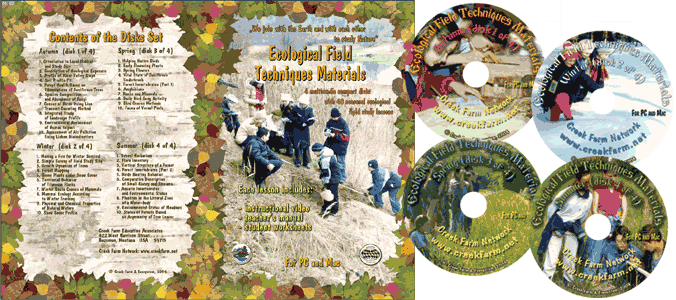|
| Our Field Ecology Center published more than
180 methodical materials for nature studies. Some of them are in English: |
|
|
|
Study of the Vertical Structure of a Forest
© Alexsander S. Bogolyubov,
Nadejda S. Lazareva, Russia, 1999
© Michael J. Brody, USA,
2003
 This manual describes a procedure for the study of the
vegetative community of a forest. It includes a description of the main characteristics of
vegetative canopies, species composition, and ratios of different plant species in the
community based on their relative numbers, and for tree and shrub layers, the diameter of
trunks, height and age. This manual describes a procedure for the study of the
vegetative community of a forest. It includes a description of the main characteristics of
vegetative canopies, species composition, and ratios of different plant species in the
community based on their relative numbers, and for tree and shrub layers, the diameter of
trunks, height and age.
This field study has instructional video
featuring real students conducting the ecological field techniques in nature. Each video
illustrates the primary instructional outcomes and the major steps in accomplishing the
task including reporting the results.
Introduction
In nature, plants are distributed into layers. Each layer is a height group,
depending on their demands for sunlight. Layers are easily visible in the forest since the
plants share not only light, but also space for their crowns.
The number of layers in the forest community can vary greatly. In communities that are
rich in resources and species, there are more layers; for example, in tropical
rainforests, there can be more than 20 layers.
The forest structure of a moderate climatic zone is usually simpler, with not
more than five layers. These forests are usually represented by three layers: the tree
layer, made up of adult trees (ripe stand), the bush layer, meaning those that
actually form the so-called "forest" bushes, which never grow high; and a layer
of underwood, consisting of young trees, which grow to the first layer over the
course of time. In addition to these three layers are two layers of soil surface cover; an
herbaceous-shrub layer formed with herbaceous plants and shrubs, and a moss
layer of terrestrial mosses and lichens.
Not all layers are present at each forest type. For example, young spruce forests,
where dense spruce crowns are pulled closely together, often consist only of two layers -
forest and moss. There are also forests where the number of layers is higher; for example,
stands consisting of several species of adult trees which greatly differ in height.
Procedure for the Geobotanical Description
The objective of this ecological field study is to have students describe the layered
structures of a forest and to compare the structures of different plant communities. The
completion of this task will help students learn the structure of the regional vegetation.
Studying typical plant species with plant associations will help students learn the skills
of botanical description, which are often necessary for research work on other subjects
and natural objects. It is good to keep in mind that this procedure is greatly simplified
and can be recommended only for educational purposes.
Materials and equipment
For an elementary geobotanical description it is necessary to have the following: a
report form (Table 1 at the end of this manual), a tape measure for dividing a site and
for the measurement of the length of the fallen trunk (in meters), a centimeter ruler for
the measurement of trunk diameters, and an altimeter (if one is available). A bag or
herbarial folder for collection of unknown plants can also be useful. Paper envelopes are
required for the collection of mosses.
Site selection
The work should start with the selection of a place for descriptions and laying down a
test site. It is more convenient to begin this study with simple plant associations
where the layered structure is well expressed and can be easily described, for example, a
homogeneous coniferous forest. If such a site is not available, any other type of the
forest with expressed layered structure and a small number of species can be chosen.
It is best if a homogeneous (average in every respect and section) forest is chosen for
description.
A square of approximately 10 x 10 meters is measured and the outline marked with
colored tape. If the association is thinned out, i.e. trees are found at great distances
from each other; the site can be larger in size. If colored tape is not available, the
corners of...
This was only the first page from the manual and its full version you can see in the
Ecological Field Studies Techniques Video 4CD Set:
It is possible to purchase the complete set of 40 seasonal Ecological Field
Studies Techniques Video (in mpg format) in an attractive 4 compact disk set.
These compact disks are compatible with Mac and PC computers.
The videos are suitable for individual student or whole class instruction. To purchase the complete 4CD set
write to ecosystema1994@yandex.ru in a free form.

Ecological Field Studies Demo Disk:
We also have a free and interesting demonstration disk that explains our ecological field studies approach.
The demo disk has short excerpts from all the seasonal field study videos as well as sample text from all the teacher manuals.
The disk has an entertaining automatic walk through which describes the field study approach and explains how field studies meet education standards.
You can also download the Demo Disc from ecosystema.ru/eng/eftm/CD_Demo.iso.
This is a virtual hybrid (for PC and Mac computers) CD-ROM image (one 563 Mb file "CD_Demo.iso").
You can write this image to the CD and use it in your computer in ordinary way.
You also can use emulator software of virtual CD-ROM drive to play the disk directly from your hard disk.

|







